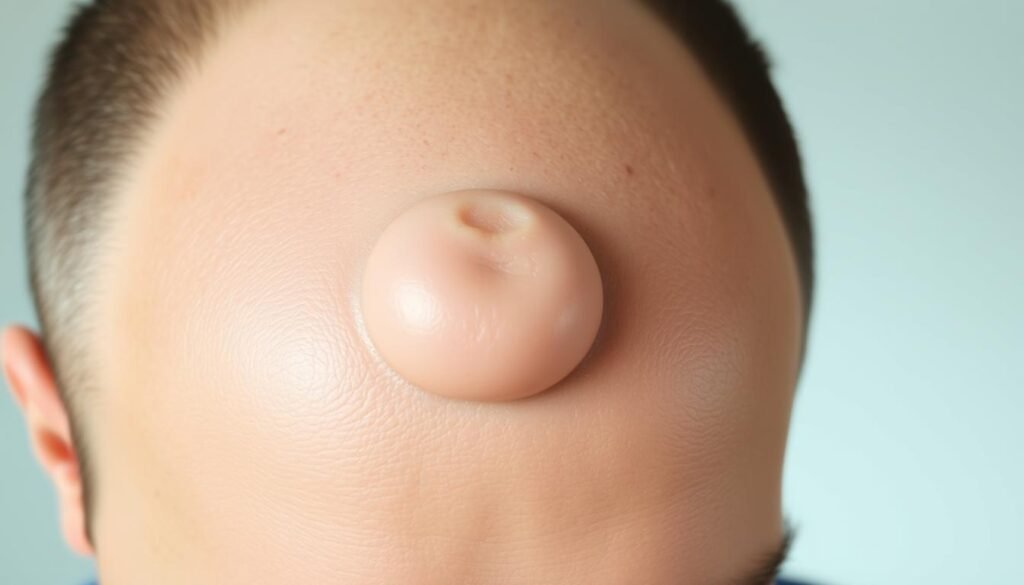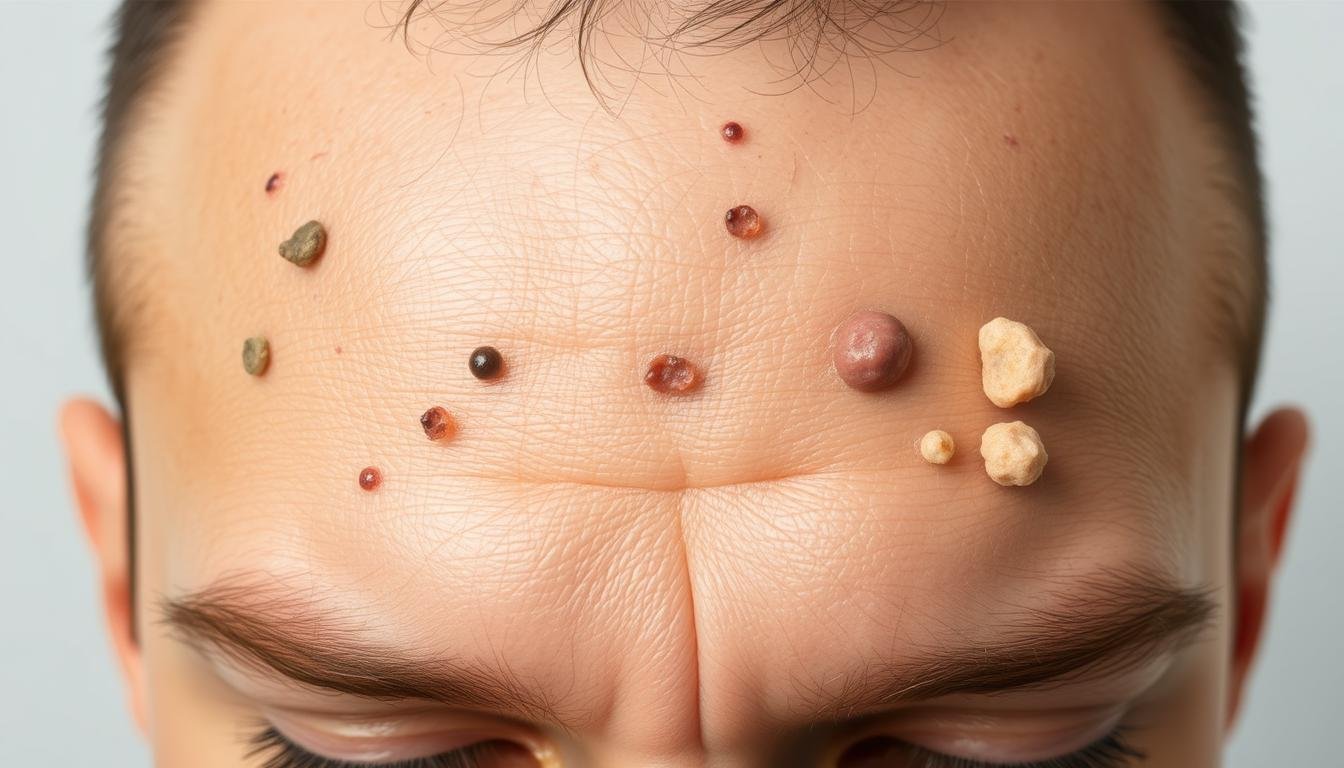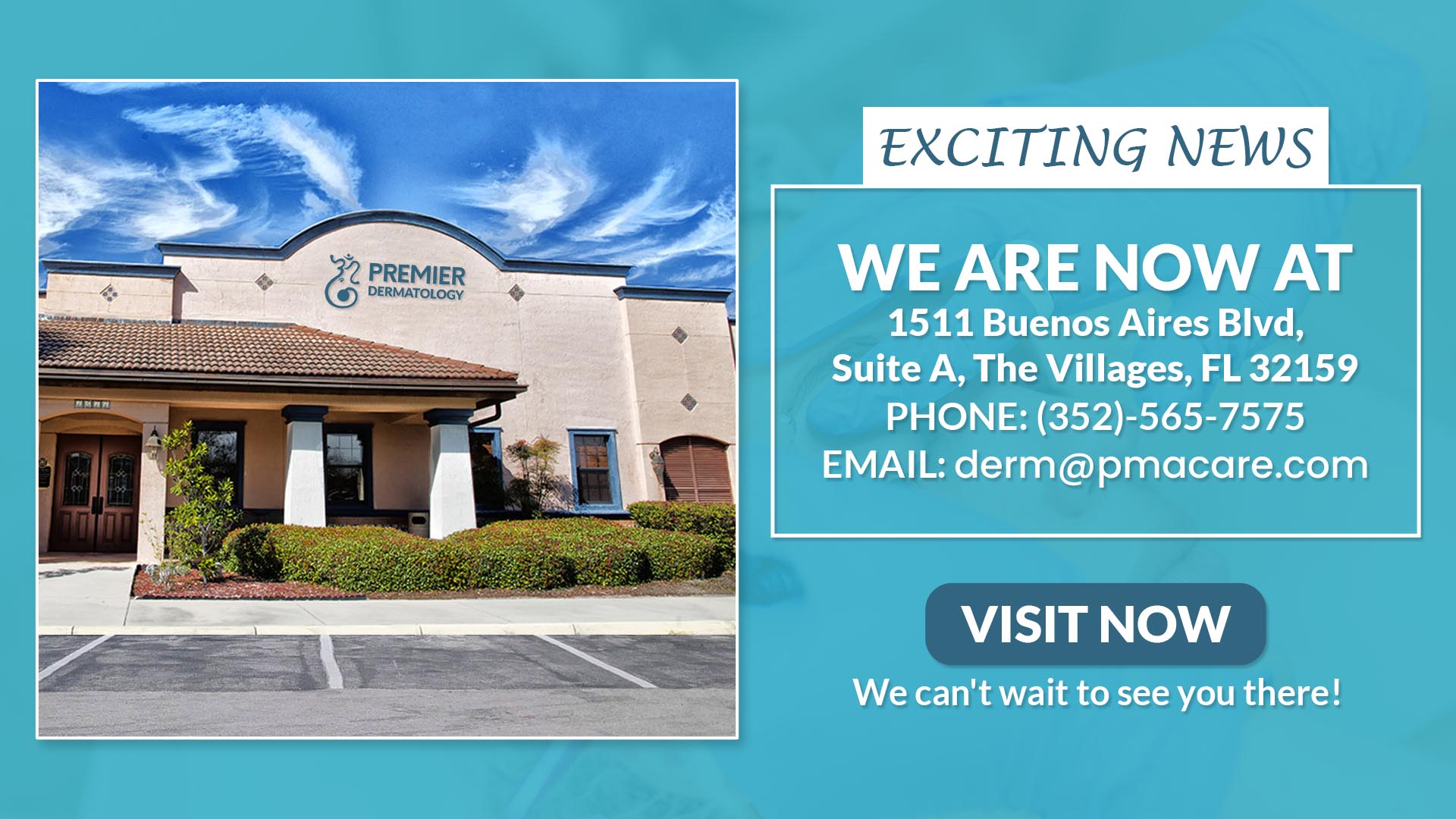Ever noticed a bump on your forehead and felt worried? You’re not alone. Many people find unexpected growths on their forehead, causing health concerns.
Forehead bumps can come from simple pimples to serious skin issues. Knowing what they are can ease your mind and guide you to the right doctor.
In this guide, we’ll look at the different forehead bumps, their causes, and when to see a doctor. Our goal is to give you clear, reassuring info on these skin changes.
Key Takeaways
- Most forehead bumps are harmless and do not require immediate medical intervention
- Different types of growths include pimples, cysts, lipomas, and osteomas
- Persistent or changing forehead bumps should be evaluated by a healthcare professional
- Trauma, infections, and skin conditions can contribute to forehead growths
- Early detection and understanding are key for proper management
Common Types of Forehead Growths
Knowing about the different growths on the forehead is important. A lump on your forehead could be something simple or serious. It’s always best to check with a doctor.
There are many kinds of forehead bumps, each with its own signs and health risks. We’ll look at the most common ones.
Benign vs. Malignant Growths
Not every forehead bump is a worry. Many are benign skin conditions that are not harmful. But knowing the difference between harmless and dangerous growths is key.
- Benign growths: Generally harmless and non-cancerous
- Potentially malignant growths: Require immediate medical attention
Identifying Different Growth Patterns
Knowing how to spot different skin growths is important. Here are some common ones:
- Moles (nevi): Usually harmless, but require monitoring
- Skin tags: Small, soft tissue growths
- Cysts: Fluid-filled sacs beneath the skin
- Lipomas: Soft, fatty tissue growths
Risk Factors for Development
Several things can make a forehead bump more likely. These include:
- Genetic predisposition
- Sun exposure
- Age
- Hormonal changes
Early detection and professional evaluation are key to managing any unusual skin growth.
Recognizing Forehead Cysts and Their Characteristics
A forehead cyst can be a worrying skin growth. These lumps are filled with fluid and look round or dome-shaped. Most are harmless, but knowing when to see a doctor is important.
Our skin can get various cysts, each with its own traits. Figuring out the cyst type needs careful look at its look and any symptoms.
- Epidermoid cysts: Filled with dead skin cells
- Typically white or yellow in color
- Grow slowly and remain painless
- Most commonly found on face and neck
Swelling on the forehead can mean different cysts. Watch for:
- Size and shape
- Color and texture
- Pain or tenderness
- Rate of growth
“Not all forehead growths are cause for immediate concern, but professional evaluation is always recommended.” – Dermatology Experts
Dealing with cysts can involve watching them, injections, or surgery. Steroid shots might help with swelling. Surgery can stop them from coming back. Antibiotics might be needed if it gets infected.
Growth on Forehead: Medical Assessment Guide
Identifying and evaluating skin growth on the forehead needs a detailed medical approach. Knowing the diagnostic steps helps patients deal with concerns about bumpy foreheads.
Physical Examination Essentials
Doctors carefully check forehead growths during a medical assessment. They use several important techniques:
- Visual inspection of size, color, and texture
- Palpation to assess depth and consistency
- Checking for pain, tenderness, or sensitivity
- Evaluating surrounding skin conditions
Diagnostic Testing Methods
Doctors use different tools to understand forehead skin growths:
| Diagnostic Method | Purpose |
|---|---|
| CT Scan | Detailed imaging of underlying structures |
| Ultrasonography | High-resolution soft tissue evaluation |
| Biopsy | Cellular-level analysis for possible malignancies |
When to Seek Professional Medical Help
Certain signs mean you should see a doctor right away for a bumpy forehead growth:
- Rapid changes in size or appearance
- Persistent pain or discomfort
- Bleeding or unusual discharge
- Associated fever or systemic symptoms
“Early detection and professional evaluation are key to managing any unusual skin growth.” – Dermatology Professional Guidelines
Our medical experts suggest a thorough check for any lasting or worrying forehead skin growth. This ensures the right diagnosis and treatment.
Understanding Forehead Hematomas
A forehead hematoma is when blood collects outside blood vessels after trauma. It looks like a “goose egg” swelling. This happens when a big impact breaks blood vessels under the skin.
Knowing what a forehead mass looks like is key. Most come from head injuries. They show up as raised, discolored spots on the skin.
“Not all head bumps are cause for serious concern, but monitoring symptoms is essential” – Pediatric Healthcare Professionals
Signs that mean you should see a doctor include:
- Persistent swelling lasting more than 48 hours
- Changes in consciousness or alertness
- Severe pain at injury site
- Confusion or memory loss
- Balance disruptions
Some groups are more at risk for forehead hematomas. People over 65 and those on blood-thinning meds are more likely to get them.
First steps for care are:
- Applying cold compress
- Keeping the head elevated
- Monitoring for neurological changes
- Seeking professional medical evaluation
Remember: While most hematomas heal on their own, if symptoms don’t get better, see a doctor.
Lipomas: Soft Tissue Growths on the Forehead
Lipomas are soft tissue growths that can appear on the forehead and other body parts. They are benign fatty tumors. Many people will get a lipoma at some point in their lives.

Knowing about these growths helps people spot health issues early. Lipomas look like soft, movable lumps under the skin. They can make a noticeable bump on the forehead, which might worry you about how you look.
Causes and Risk Factors
Several things can lead to lipomas:
- Age: They often show up in people aged 40-60.
- Gender: Men are slightly more likely to get them.
- Potential risk factors include:
- Diabetes
- Obesity
- Physical trauma
- Insulin injections
- Corticosteroid use
Treatment Options for Lipomas
There are a few ways to treat a forehead growth:
- Surgical Excision: This is the most common way to remove lipomas.
- Liposuction: It’s a less invasive option.
- Endoscopic removal: This method can help reduce scarring.
“Most lipomas do not require removal unless they cause pain or cosmetic concerns” – Dermatology Research Institute
It’s important to talk to a doctor to figure out the best treatment for your forehead bump. They can help make sure you get the right care for your lipoma.
Osteomas: Bony Growths and Their Impact
A lump on your forehead might be an osteoma. It’s a benign bony growth that can appear on the skull or other body parts. These growths are hard and don’t move, often found during routine check-ups.
Osteomas are interesting bone tumors with unique traits:
- Typically non-cancerous growths
- Most commonly found on the skull
- Can vary significantly in size
- Often asymptomatic
Our research shows there are three main types of osteomas:
- Compact osteomas: Dense bone structure
- Spongy osteomas: More porous bone formation
- Mixed osteomas: Combination of both structures
“Understanding your body’s unique growth patterns is key to maintaining optimal health.” – Neurosurgical Research Institute
Symptoms can appear based on where and how big the osteoma is. Possible issues include:
| Location | Potential Symptoms |
|---|---|
| Near Sinuses | Potential sinus infections |
| Near Eye Socket | Possible eye protrusion |
| Jawbone | Potential facial pain |
Even though most osteomas are harmless, it’s wise to see a doctor if you notice a lump on your forehead. Our healthcare team can do thorough tests like CT scans to check these growths.
Treatment Options for Forehead Bumps
Dealing with a swelling on forehead or a cyst on forehead can be tough. We know how important it is to find the right treatment. It should match your specific skin concerns well.
When looking at treatments for forehead growths, you have many choices. These range from surgical to non-surgical options. Our guide will help you find the best treatment for you.
Surgical Interventions
Surgical treatments are needed when forehead bumps are risky or ugly. Our top surgical options include:
- Excision of larger cysts or growths
- Laser removal for precise targeting
- Minimal invasive procedures with quick recovery
Non-surgical Alternatives
For small swelling on forehead, non-surgical treatments work well:
- Topical medications
- Prescription-strength retinoids
- Photodynamic therapy
- Chemical peels
“About 70-90% of patients see big improvements with medical treatments,” says the American Academy of Dermatology.
Recovery Expectations
Recovery time depends on the treatment. Non-surgical methods usually need little downtime. Surgical options might take 1-2 weeks to heal. Patients should:
- Follow post-treatment care instructions
- Avoid direct sun exposure
- Maintain proper skincare routine
Always talk to a dermatologist to find the best treatment for your forehead cyst or skin growth.
Managing Post-Traumatic Forehead Swelling
Forehead trauma can lead to skin growth or a bumpy forehead. It’s important to manage swelling well for healing. This helps in the recovery process.
After a head injury, quick action is key. Here are some important steps:
- Apply ice within the first 24-48 hours to reduce inflammation
- Keep the injured area elevated to minimize blood accumulation
- Use gentle compression with a clean cloth
- Monitor symptoms closely for possible complications
The severity of the injury affects treatment. Mild injuries might heal with home care. But, more serious cases need a doctor’s help. About 20% of head injury patients develop a serious blood clot inside the brain.
“Swift and appropriate response to head trauma can prevent long-term complications” – Sports Medicine Research Institute
Watch for these warning signs that mean you need to see a doctor right away:
- Persistent confusion
- Uncontrolled bleeding
- Seizures
- Prolonged unconsciousness
- Severe headaches
For both kids and adults, it’s vital to watch for symptoms. A bumpy forehead could be a sign of something serious. If symptoms don’t get better or get worse, go to the emergency room.
Prevention and Early Detection Strategies
Understanding and managing abnormal forehead growth needs proactive health steps. While not all forehead masses can be prevented, some strategies can help reduce risks and spot issues early.
Preventing forehead masses involves many lifestyle and health factors. Our approach aims to lower risk factors and keep a close eye on your health.
Lifestyle Modifications to Reduce Forehead Mass Risk
- Protect skin from too much sun
- Eat a balanced diet full of antioxidants
- Practice good hygiene and skin care
- Avoid hitting your forehead
- Manage any health problems you have
Regular Self-Examination Techniques
Finding an abnormal forehead growth early can greatly improve treatment results. We suggest a detailed self-examination routine:
- Do a monthly visual check
- Use bright light and a mirror
- Look for size, color, or texture changes
- Notice any new or odd bumps
- Take photos of any suspicious spots
“Early detection is your best defense against forehead masses”
Risk Factor Analysis
| Risk Factor | Potential Impact |
|---|---|
| Sun Exposure | High risk of skin problems |
| Genetic Predisposition | Higher chance of forehead growths |
| Chronic Skin Conditions | Can trigger mass development |
By using these prevention strategies and doing regular self-exams, you can actively manage forehead mass risks.
Emergency Signs and Symptoms
It’s important to know the warning signs of a growth on your forehead. Some symptoms need quick medical help to avoid serious problems.
Our medical experts say watch out for these urgent signs:
- Sudden change in forehead bump size or appearance
- Persistent pain or tenderness around the growth
- Bleeding that doesn’t stop within 10-15 minutes
- Signs of infection like redness, warmth, or pus
- Rapid swelling or inflammation
Here are some emergency signs to look out for:
- Neurological changes: Unexplained headaches, dizziness, or vision disturbances
- Fever above 101°F accompanying the forehead bump
- Loss of consciousness or sudden cognitive changes
“Any unusual growth requires professional medical assessment to rule out serious conditions.” – American Medical Association
People over 60 should be extra careful. They are at higher risk of serious health issues from head injuries. Studies show over 40% of older adults have less brain volume, making them more vulnerable.
If you’re unsure, get medical help right away. Quick diagnosis can prevent long-term damage and ensure the right treatment for forehead growths.
Natural and Home Remedies for Minor Growths
Many people look for safe ways to handle a lump on their forehead or a small bump. It’s important to know how to care for minor skin issues at home. But, it’s also key to know when to see a doctor.
Our research shows several home care options for minor forehead growths:
- Apply cool compresses to reduce inflammation
- Use over-the-counter topical creams with anti-inflammatory properties
- Maintain excellent personal hygiene
- Monitor growth size and appearance regularly
Effective Home Care Methods
For minor skin irritations on the forehead, try these gentle methods:
- Clean the area with mild, fragrance-free soap
- Apply tea tree oil diluted with carrier oil
- Use aloe vera gel to soothe possible skin inflammation
“Prevention and careful observation are key to managing skin growths effectively.” – Dermatology Research Institute
When to Avoid Self-treatment
Not all forehead lumps can be treated at home. See a doctor right away if you notice:
- Rapid growth of the lump
- Persistent pain or discomfort
- Changes in color or texture
- Bleeding or oozing
- Accompanying fever or systemic symptoms
Home remedies can offer temporary relief. But, they should not replace a doctor’s check-up. Always put your health first and see a healthcare provider for the right diagnosis and treatment.
Post-Treatment Care and Follow-up
After treating a swelling on your forehead or a cyst, it’s important to follow up properly. This helps your healing and prevents problems. Our guide will help you feel confident during your recovery.
Follow-up visits are key to check how you’re healing. How often you need to go depends on:
- Type and stage of the original growth
- Size and depth of the removed lesion
- Individual patient health conditions
If you’ve had skin growths before, you might need to see your doctor more often. Experts suggest personalized follow-up plans to catch any signs of growths coming back early.
*”Consistent follow-up is your best defense against future skin health challenges.”*
Wound care is very important after treatment. Here are some key tips:
- Keep the wound clean and dry
- Wash around the wound with clean water twice daily
- Apply petroleum jelly to prevent scab formation
- Avoid direct sun exposure during healing
Most wounds heal in 1-3 weeks. Stitches are usually removed between 5-14 days after the procedure. Your doctor will tell you exactly what to do based on your situation.
It’s normal to feel anxious during follow-up visits. Talking openly with your healthcare team can help. It ensures you get the care you need.
Understanding Complications and Risks
Forehead growths can have different complications that patients need to know about. Most forehead skin growths are harmless, but some risks need medical attention. Bumpy foreheads might show health issues that need a doctor’s check-up.
- Infection of the growth area
- Potential scarring
- Unexpected changes in size or appearance
- Potential malignant transformation
Some people are more likely to get forehead growths that could be a problem. These include:
- Prolonged sun exposure
- Genetic predisposition
- Compromised immune system
- Advanced age
“Early detection and professional medical assessment are key to managing skin growth complications.”
Our research shows some groups face higher risks. For example, people over 50 are more likely to get complex forehead growths. About 4% of head and neck cancers are linked to skin issues.
| Risk Category | Potential Complications |
|---|---|
| Low-Risk Growths | Minor cosmetic concerns |
| Moderate-Risk Growths | Potential infection, slight transformation risk |
| High-Risk Growths | Possible malignant development, surgical intervention required |
Watching your growths closely and getting medical advice is the best way to handle forehead skin growth risks.
Latest Medical Advances in Forehead Growth Treatment
Medical technology is changing how we diagnose and treat abnormal forehead growth. Our understanding of managing forehead masses has grown a lot. Now, we have new, precise, and less invasive treatments for patients.
New discoveries are changing how we tackle tough forehead growths. This brings hope to those with hard-to-treat medical conditions.
Innovative Surgical Techniques
Surgeons are now using new methods to treat forehead masses with less harm. Some key advances include:
- Endoscopic endonasal approach (EEA), which uses natural sinus openings
- Minimally invasive surgical methods reducing recovery time
- Precision targeting of abnormal forehead growth
Modern Diagnostic Tools
We can now find and diagnose forehead masses earlier and more accurately.
- High-resolution imaging techniques
- Advanced genetic screening
- Molecular diagnostic methods
“Technology has transformed our ability to diagnose and treat complex forehead growths with unprecedented precision.” – Medical Research Institute
Treatment success rates vary, but surgery is showing great results. For example, small basal cell carcinomas can be cured up to 95% with advanced surgery.
New treatments like targeted molecular therapies and immunotherapies are also on the horizon. They offer new hope for those facing tough forehead growth challenges.
Specialized Treatment Centers in Florida

Finding the right place for forehead growth treatment is key. Our network in Florida offers top-notch care for forehead bumps and more. We have the best facilities to help you.
Our top treatment spots in Florida offer the latest in diagnosis and treatment. Here are some of our best locations:
- Orlando: Advanced Dermatology Center
- Clermont: Comprehensive Skin Health Clinic
- The Villages: Regional Dermatology Specialists
- Kissimmee: Skin and Growth Evaluation Center
- Ocala: Specialized Dermatological Care
- Bushnell: Central Florida Skin Consultations
- Belleview: Forehead Growth Diagnostic Unit
We use the latest tech and care for each patient personally. Every forehead bump is different, and we treat it as such.
“Quality care meets compassionate treatment at our Florida medical centers”
Need help with your forehead growth? Call our patient support line: +1(352) 565-7575. Our team is ready to help with all your needs.
| Location | Specialization | Contact Focus |
|---|---|---|
| Orlando | Advanced Diagnostic Techniques | Complex Forehead Growths |
| Clermont | Comprehensive Skin Assessment | Benign and Malignant Evaluations |
| The Villages | Specialized Dermatological Care | Geriatric Skin Condition Management |
We focus on educating patients, early detection, and precise treatment. Our team ensures you get the best care for your forehead bump.
Conclusion
We’ve looked into forehead growths in detail, from spotting a lump to finding treatments. It’s key to get a doctor’s check when you see something odd on your forehead. Early action and the right medical care can make a big difference.
Studies, like the one in the National Center for Biotechnology Information database, show most forehead growths are harmless. They can be treated with the right care. People’s stories show how important the right diagnosis and treatment are.
Take care of your health by checking yourself often and knowing the risks. If you notice anything different, see a doctor right away. Most forehead growths can be handled with the right medical help.
Being informed and watching for changes is your best defense against forehead growths. Stay up to date, stay alert, and always put your health first. This way, you can make smart choices about your health.



